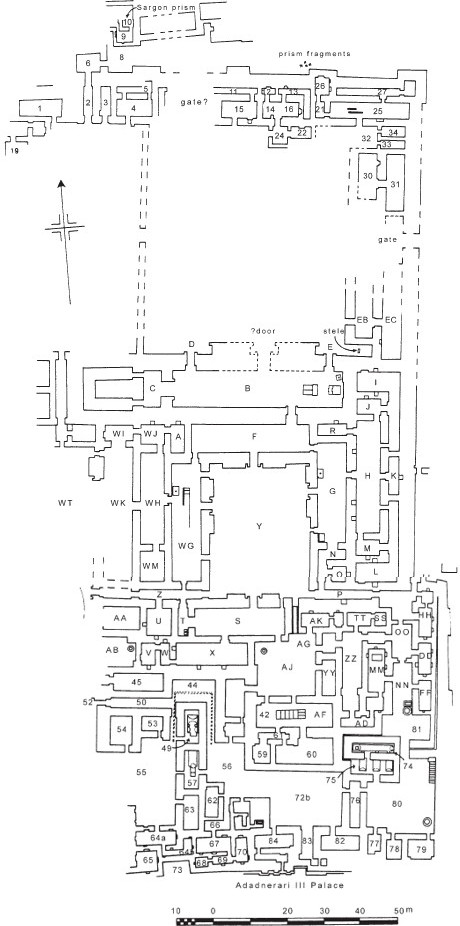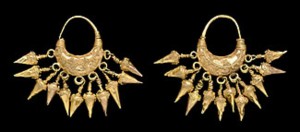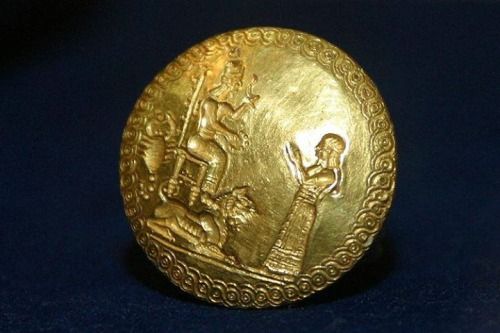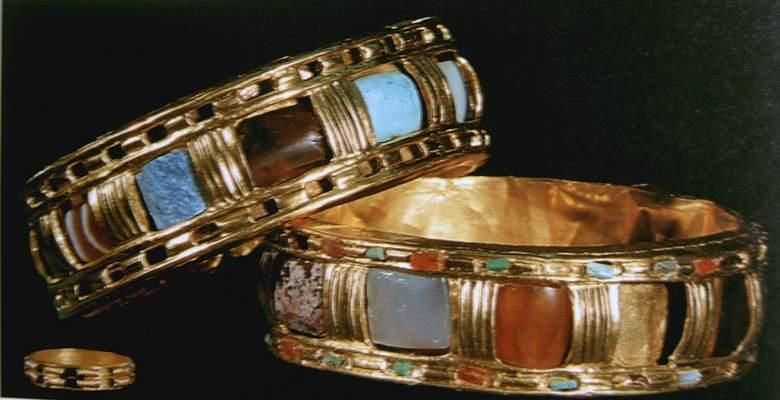"Graverob-Dungeoneering. Yeah, dungeoneering." (Part 3.1 - Neo-Assyria)
In this post I will be exploring the final of the three example tombs. This one is the youngest of the three, and is a great window into treasure right before the use of coins. These tombs are referred to as the "The Queens' Tombs" of Nimrud. There are four tombs, each with a queen, dating from 700-900 BC. Much like the tomb of Queen Puabi, these tombs were found in a greater complex. In this case, that greater complex is not a cemetery, but a palace: the Northwest Palace of Assur-nasir-pal II.
In order to keep the length of this post manageable, and to save my eyes from bugging out too much, I have split this final tomb into two sections. This post, 3.1, gives a brief introduction to Neo-Assyria and the Northwest Palace, and then discusses Tomb I and Tomb II. The following post, 3.2, will discuss Tomb III and Tomb IV and include my further thoughts.
As in my previous two posts, I will be listing a lot of items. I have included pictures of some of them. A picture of nearly every single item found across the four tombs can be found at this link:
This book was written by Muzahim Mahmoud Hussein, who discovered the tombs. It contains over 350 pages of descriptions of all the items found in these tombs, alongside hundreds of pictures and illustrations. This resource is invaluable. I reference this book nearly constantly throughout this post, so I would recommend having it open. My post condenses the finds as much as possible for readability purposes; read the book. Seriously. Read the book.
If you want other resources for pictures or information, here:
*Assyrian International News Agency
Assurnasirpal II's Palace
I want to briefly mention Assurnasirpal II because these tombs were found within his palace complex. He reigned over the Assyrian Empire from 883-859 BC. His reign was defined by expansion of the Assyrian empire through conquering the surrounding nations. His palace was in Kahlu, the biblical Calah. His palace is the source of many recognizable inscriptions and reliefs. His palace was rediscovered in 1845 AD by A. H. Layard.
Reliefs



Northwest Palace

Queens' Tombs Section
This is the layout of the Northwest Palace, our map of the "dungeon". The Queens' Tombs section is considered to be in the Southern Section.
The Queens' Tombs History
Even though the Northwest Palace was discovered in 1845, the tombs were not discovered until the 1989s by the Iraqi Department of Antiquities. Muzahim Mahmoud Hussein and his team noticed some bricks in the floor were uneven, rising at odd angles (a perceptive adventurer!). He and his team pulled up the bricks and, over time, discovered the four tombs. The vaulted ceiling of Tomb I was pushing the bricks up.
The palace was excavated from 1985-1993 by Muzahim and his team, and resumed briefly in 2002-2003. Military conflicts within Iraq during 1993-2001 and after 2003 stopped the excavation process. The tombs were discovered in 1989. Beyond this, 2003 saw looting and destruction of many artifacts within the State Board of Antiquities and Heritage which is connected to the Iraq National Museum. Muzahim Mahmoud Hussein's original manuscript was one such artifact destroyed at this time.
Lastly, the Islamic State of Iraq and the Levant (ISIL/ISIS) purposefully destroyed the Northwest Palace in 2015 due to the "idolatrous imagery and architecture". It is doubtful the Queen's Tombs survived. This battered past of this beautiful site is incredibly depressing, but thankfully we have access to Muzahim's book. We may never get the tombs as they were, but they have been recorded by Muzahaim, and for that I am ever grateful to him and his team.
The Queens' Tombs
The majority of the tombs were made of baked brick, though other stones and materials were used throughout. They were buried below the floors of the rooms they were found in.
The women in the tombs are most likely:
- Mullissu-Mu-kannishat-Ninua, wife of Assurnasirpal (883-859 BC)
- Hama, wife of Shalmaneser IV (782-773 BC)
- Yaba', wife of Tiglath Pileser III (744-727 BC)
- Banitu, wife of Shalmeneser V (726-722 BC)
- Atalya, wife of Sargon II (721-705 BC)
The word used for these women is "segallu" which means "woman of the palace". Each was a wife of a king and was considered the "ruler of the domestic realm". They are buried in the Southern Section, under the "domestic parts" of the palace which would include the royal harem.
Tomb I - Unknown (Room MM)
Illustrations of the tomb are on pg. 226-228, Plates 9-11
Images of the finds within the tomb are on pg. 229-239, Plates 12-22
This tomb is alone, buried under the floor. The only indication it exists is disturbed bricks in the floor. It appears as though something round is pushing up through the bricks. Should the party take to digging, about a foot under the floor they would find a grave with a baked clay coffin. Within the coffin are the skeletal remains of a human.
In the coffin with the remains is a golden brooch with a golden chain. On the other end of the golden chain is a chalcedony stamp seal set in gold. Alongside this brooch is a small golden head with hollow eyes and a snub nose: a depiction of a demon.
If the party quits now, they will miss out on the vaulted tomb beneath their feet. Continual digging in the floor will break through the vaulted ceiling of baked bricks. Landing in the middle of the room, the floor is covered in three feet of dirt which has settled over the centuries. The bricks of the tomb have inscriptions on them telling of the glory of a long-ago king. Within the dirt are a few objects of bronze, a few articles of gold jewelry, and ritual objects in the shape of animals.
To the south is an archway which leads to a collapsed stairway. At the threshold of the entrance are three items: a ceramic jar and two white, marble amphorae. Along the western wall is a sarcophagus, hidden under all the dirt and built into the floor. The only evidence of something is a small recess in the northwestern corner. Digging there reveals the sarcophagus.
In the sarcophagus are the following, in various places around the skeletal remains:
- Stamp seals with precious stones set in gold with intricate designs
- Tin-glazed stamp and cylinder seals
- A gold fibula of a mermaid and an owl
- Dozens of tin-glazed and gold beads in the shape of flies
- Rings and earrings of precious stones and gold
- Golden bracelets inlaid with precious stones
- A necklace of gold, tin-glazed, and stone
- Amulets and pendants of stone in the shapes of animals
- Three small figurines depicting "erotic acts"
- Alabastra containing perfumes, spices, and other precious substances
- Small, tin-glazed bottles and small crystal bottles
- A bronze mirror
Additionally, in the dirt of the tomb are a few small golden pieces of jewelry and beads.
Earrings

Fibula/Pin
Stamp Seal

Bracelets

Most of these items are small and would fit either on the party or in one of their bags. Being of gold and precious stones, majority of these items would have some value despite their size. Couple this with the artistry displayed in them and their value increases dramatically.
Tomb II - Yaba & Ataliya/Banitu (Room 49)
Illustrations and images of the tombs are on pg. 242-249, Plates 25-32
Images of the finds within the tomb are on pg. 250-308, Plates 33-91
Layout
The party continues through the "dungeon". The move from MM and make their way back to room AJ, a central courtyard previously cleared, to count up their treasures. Happy, but not quite satisfied, they decide they can continue exploring since the haul was mostly a lot of small things.
They travel from room AJ to room 56, another large room, through rooms 43 and 46. They decide to go west, as they have not explored this area yet. They take the north hallway to room 44, then south into the outer courtyard of room 55. It is here, outside in the open, that they decide to take a turn to rest. Looking at the walls around them, they notice one wall on the east of the courtyard is crumbling inwards. Another turn later and they have found a hidden room (room 49)!
The room is scattered with debris a few feet thick. In certain places the debris is raised as though resting on something. In the northern section of the room is a small ceramic pipe sticking out of the debris. Some initial digging reveals two massive limestone slabs in the floor. Under these slabs, should the party move them or break them, are two vaulted ceilings, the longer running north-south and the shorter running east-west.
The party may enter through the ceilings of these vaulted tombs as before, but if they continue searching through the debris they will find a third limestone slab, this one square and set into the floor. Removing it reveals a square hole in the ground. This is the entrance into the underground tombs. They have entered Tomb II.
Dropping into the tomb the party first enters and antechamber.
The Antechamber
Marble slabs make up the floor of the antechamber. The dirt here is much less than previous tombs. Scattered about the dirt are a few items:
- Ceramic jars
- A bronze lamp
- Bronze cups and other objects
In a niche in the western wall is a marble tablet written in an ancient language. If the party is able to read it, it reveals the identity of the deceased - Queen Yaba. Written on the tablet is also a curse for anyone who disturbs the tomb or places another body in it. Uh oh!
Two large stone doors block an entrance into the next room, held in place by a metal bar. The metal bar must be broken to move the stones on their hinges. A sufficient heat source would work, as would raw power; the first takes time, the second makes noise. The party, feeling safe in a hidden away place, decide to melt the bar, freeing the stone doors and revealing another room.
The Burial Chamber
Within the burial chamber are more niches, these containing marble jars with human skeletal remains and organs inside of them. In another niche is a lamp like the one in the antechamber. A few other items - ceramic jars and bowls, bronze bowls, gold dishes, and other smaller treasures are about the burial chamber floor.
Of primary importance, however, is the sarcophagus which takes up the northern end of the chamber. It is one piece of white stone of immense weight. Removing the lid reveals the skeletal remains of two bodies in white clothing. Buried with them are 700 objects, such as:
- Gold jewelry, such as earrings (hundreds of them), bracelets, torcs, collars, necklaces, rings, cuff links, fibulae, and anklets; many of which also have precious stones
- A bronze mirror with a handle of precious stones, gold, and ivory
- Gold foil items of various shapes within the folds of the clothing
- A gold bowl containing gold vials
- A crown of women gold bands inlaid with precious stones
- A diadem of woven gold inlaid with precious stones
- Four gold pendants, one with a hollowed snakehead, all with various precious stones
- Cups, jars, plates, lamps, mirrors, and combs made of various precious metals, precious stones, and crystal
- A bronze paperweight in the shape of a duck
- Items of carved ivory and bone
Gold Crown with Foil Rosettes

A Necklace

Diadem Segments - Sacred Tree & Palm Tree
A Gold Dish
A Gold Bracelet

Duck Weight

This is not the actual duck weight, but it is the right general design. The actual duck weight does have a picture in the book on pg. 299, Plate 82.
Jackpot! This tomb alone will make the party rich beyond their wildest dreams. Who cares about a curse when you're rich beyond your wildest dreams? The human remains in the jars and a lot of the jewelry looking like it has eyes staring at you is just a coincidence, right? Right?




